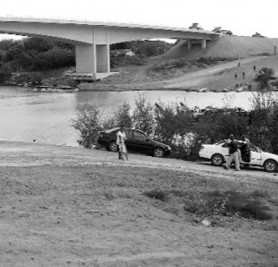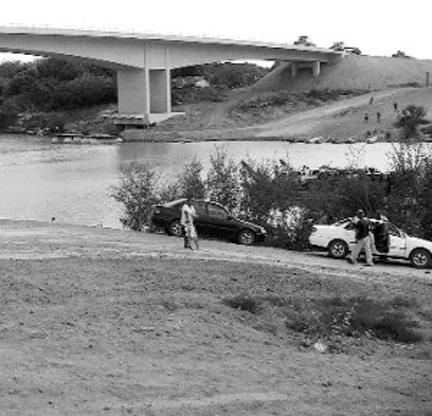This week, Arts on Sunday revisits the comparative literature of Guyana and Brazil as relations between the two South American neighbours deepen and the University of Guyana renews its study of Portuguese. Visiting Professor Miguel Neneve of the Department of Language and Cultural Studies at the University of Guyana and Roseli Siepamann of the University of Rondonia in Brazil write about building bridges between Brazilian and Guyanese literature
By Miguel Nenevé – University of Guyana
and Roseli Siepamann – University of Rondonia

Depending on their political position people have the most varied views of the advantages and disadvantages of the bridge. In this article we would like to discuss the relations between Brazil and Guyana from a different approach; one not always used for such analysis: we refer here to the field of literature.
The presence of Brazil does not appear to be common in Guyanese literature and vice versa. In fact, as Brazilian readers, we feel the absence of a look at Brazil by Guyanese writers, as most of them prefer to look at the North and explore the Caribbean context. The mention of the border of Brazil in Wilson Harris’s Palace of the Peacock seems to be a beginning. However, there are two authors who we would like to explore here who invite the readers to be aware of the geographical context of Guyana and realize the real presence of Brazil. One of these is Cyril Dabydeen, born in Berbice, and the other is Pauline Melville born in the region of Rupunini. Both of them have been living abroad for a long time, but keep writing about their country.

Before leaving for Canada, Dabydeen won the Sandbach Parker Gold Medal for his poetry (1964) here in Guyana. Today, a lecturer at the University of Ottawa, having lived in Canada for more than 30 years he keeps writing about his land, Guyana, never forgetting the South American context and neighbouring Brazil. In his book of short stories Black Jesus, for example, he includes the story “All for Love”, about Brazilians living in Canada. The writer explores here how the Brazilian way may be adapted to a Canadian reality. Brazilians outside Brazil seem to be attached to their country, although they know there is no possibility of returning home. The story also helps us to understand the author’s perception of Brazil, a perception drawn from his life in Guyana mixed with his Canadian experience: “The immense tropical heat, cacophony of bewildering noises in the streets; percussion and more voices everywhere. My constant imagining”.
One may also ask whether the author repeats the old stereotypes perpetuated by colonizers in their writings about Brazil and the Amazon, or whether he presents Brazil from the South American perspective. It seems that in some ways he deconstructs some views of the tropical Brazil portrayed by First World travel writers. In addition to this interesting factor, Dabydeen, as an immigrant in Canada, in many of his stories, uses memories of his life in South America mixed with some beliefs he acquired in the North.
In his book of poetry Born in Amazonia, Dabydeen explores his worldview based on his South American experience, always with a consciousness of Brazil. The legend of the jaguar is associated with its “continuing myth-making in South America.” The author suggests that in the Amazon we live mystery and fantasy – god and humans and their fellow creatures face a world of expectations, loss, and nostalgia. The jaguar is sometimes a competitor to the men – something which reminds us of the Argentinean writer Jorge Luis Borges’ story La Escritura Del Dios in which a man is in a prison facing a jaguar.
Writing about the Yanomamis in Roraima Dabydeen says: “Of the forest he has known all his life; an eye riveted to an ancient sky/as Brazil continues to shape its destiny”. Born in Amazonia, in fact, combines heterogeneous peoples, landscapes, ecology and a very significant concern with the social and historical reality of these peoples. The poet seems to be saying that we Brazilian and Guyanese, living in the frontier, are surrounded by myths which may be stories that mediate in this way between the known and unknown. Allusion to South American historical and literary characters and the use of Spanish and sometimes Portuguese words seem to reveal the poet’s desire to write from within a South and Latin American context. As in Dabydeen’s stories, the memories, and the desires of the immigrant in Canada to “fit” in the South American setting become visible in his poetry.
Pauline Melville also left Guyana many years ago and is now a British citizen. Her first novel The Ventriloquist´s Tale, however is all about Guyana and the presence of Brazil is visible from the beginning to the end of the book. In the prologue, the author mentions Mário de Andrade the creator of the novel Macunaima and proposes to “rewrite” the Brazilian work. The McKinnon family in the Rupununi has a very close contact with the country. The father of the family learned Portuguese in order “to manage when he went over the river to Brazil.” His contact with the neighbouring country, among other things, has economic motivation, as the narrator tells us: “A few weeks later, McKinnon returned in high spirits on horseback from a visit to Boa Vista in Brazil where he had heard that someone was able to grow apples”.
The narrator refers many times to McKinnon´s visit to Brazil and suggests that he once stayed there for a long period. Danny and Beatrice, McKinnon´s children who had an incestuous relationship and were trying to conceal it from the family, cross the border into Brazil. Later, being obliged to stop that relationship, Danny marries Silvana, a Brazilian girl and gets employed by a Brazilian company. Another character “resented the increasing number of alien coastlanders and Brazilians who were invading the region to settle there.” These are further references to the constant crossings of the border that have been taking place and that keep the Brazilian presence alive in the Guyanese work. The reader can even see the mention of Brazilian football: “He plays for Brazil, Marietta joked.” At the end of the book, the narrator almost reveals his name “Macu…” which can be a reminder that he is not exactly the Macunaima Mario de Andrade created, but a variant of that character.
Therefore, we suggest that both Dabydeen’s and Melville´s works are very relevant as they raise issues of space, displacement, and the significant border Guyana has with Brazil. Through their exploration of many myths and symbols belonging to the Brazilian region, and in their mention and rewriting of Brazilian authors, the writers suggest that Guyanese should be aware of the presence of Brazil in their reality.
Both works, Dabydeen´s and Melville´s are stimuli for the reader to reflect on the ecological issues and on the ongoing social and historical forces that are present in the Amazon region. Moreover, Brazilians should also be aware of Guyana, a neighbouring English speaking country rich in culture, myths, beliefs and good literature.

